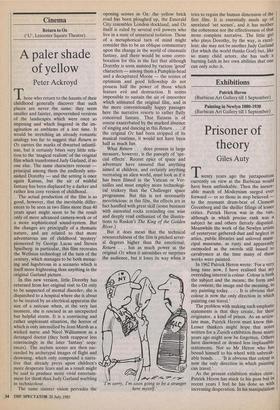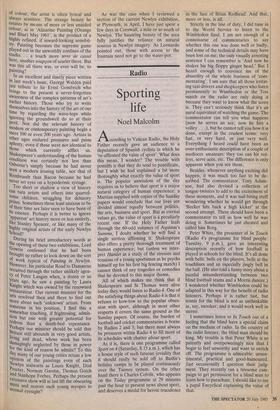Exhibitions
Patrick Heron (Barbican Art Gallery till 1 September)
Painting in Newlyn 1880-1930 (Barbican Art Gallery till 1 September)
Prisoner of theory
Giles Auty
Twenty years ago the juxtaposition currently on view at the Barbican would have been unthinkable. Then the inexor- able march of Modernism surged ever forward — or so those in step believed — to the resonant drum-beat of Clement Greenberg and the shriller filings of lesser critics. Patrick Heron was in the van, although in which precise rank was a subject he and others fiercely disputed. Meanwhile the work of the Newlyn artists of yesteryear gathered dust and neglect in attics, public libraries and unloved muni- cipal museums, as rusty and apparently outmoded as the swords still issued to cavalrymen at the time many of these works were painted.
In 1962 Patrick Heron wrote: Tor a very long time now, I have realised that my overriding interest is colour. Colour is both the subject and the means; the form and the content; the image and the meaning, in my painting today. . . . It is obvious that colour is now the only direction in which painting can travel.'
The problem with making such emphatic statements is that they create, for their originator, a kind of prison. As an articu- late man, Patrick Heron must know this. Lesser thinkers might hope that notes written for a Zurich exhibition those many years ago might now be forgotten. Others have disowned or denied less implausible statements. Not so Mr Heron who has bound himself to his wheel with unbreak- able bonds. . . It is obvious that colour is now the only direction in which painting can travel.'
As the present exhibition makes clear, Patrick Heron has stuck to his guns but in recent years I feel he has done so with increasing desperation. In his manipulation of colour, the artist is often lyrical and always sensitive. The strange beauty he creates by means of more or less unaided colour, as in 'Alizarine Painting (Orange and Blue) May 1961', is the product of a highly refined, if inward-looking sensibil- ity. Painting becomes the supreme game played out in the unworldly confines of the studio. . . a touch more terre de tassel here, another soupcon of scarlet there. But was this all there was, or ever will be, to painting? In an excellent and timely piece written in last week's issue, George Walden paid just tribute to Sir Ernst Gombrich who brings to the present a never-forgotten awareness of the complex patterns of art's earlier history. Those who try to write themselves into the history of the art of our time by regarding the wave-tops while ignoring the groundswell do so at their peril. Nor did the relevant history of modern or contemporary painting begin a mere 100 or even 200 years ago. Artists in other ages endured pressures and pains aplenty, even if these were not identical to those which currently afflict us. Shakespeare's understanding of the human condition was certainly not less than Osborne's simply because he had never seen a modern ironing table, nor that of Rembrandt than Bacon because he had never set eyes on a hypodermic syringe. Too short or shallow a view of history can turn artists and others into quarrel- some children, struggling for delusory Prizes. Sometimes those least anxious to be of their time are later seen to have been of its essence. Perhaps it is better to ignore `aPparent' art history more or less entirely, like Stanley Spencer, or like many of the highly original artists of the early Newlyn School?
During his brief introductory words at the opening of these two exhibitions, Lord Gowrie confessed that he had been brought up rather to look down on the sort of work typical of Painting in Newlyn. However, his particular Road to Damascus occurred through the rather unlikely agen- cy of Peter Langan when, a dozen or so Years ago, he saw a painting by Laura knight which was owned by the renowned restaurateur. Our current minister for the arts resolved then and there to find out more about such 'unknown' artists. From someone in his position, I find this a somewhat touching, if frightening, admis- sion but one with greater potential for redress than a death-bed repentance. Perhaps our minister should be told that Britain still abounds in very good artists, living and dead, whose work has been damagingly neglected by those in power for the kind of reason he admits? To this day many of our young critics retain a low opinion of the paintings even of such Newlyn stalwarts as Laura Knight, Dod Procter, Norman Garstin, Thomas Gotch and Stanhope Forbes. Perhaps the present extensive show will at last lift the obscuring mists and restore such young myopes to formal eyesight? As was the case when I reviewed a section of the current Newlyn exhibition, at Plymouth, in April, I have just spent a few days in Cornwall, a mile or so south of Newlyn. The haunting beauty of the area fully justifies the reliance on natural sources in Newlyn imagery. As Leonardo pointed out, those with access to the fountain need not go to the water-pot.



















































 Previous page
Previous page